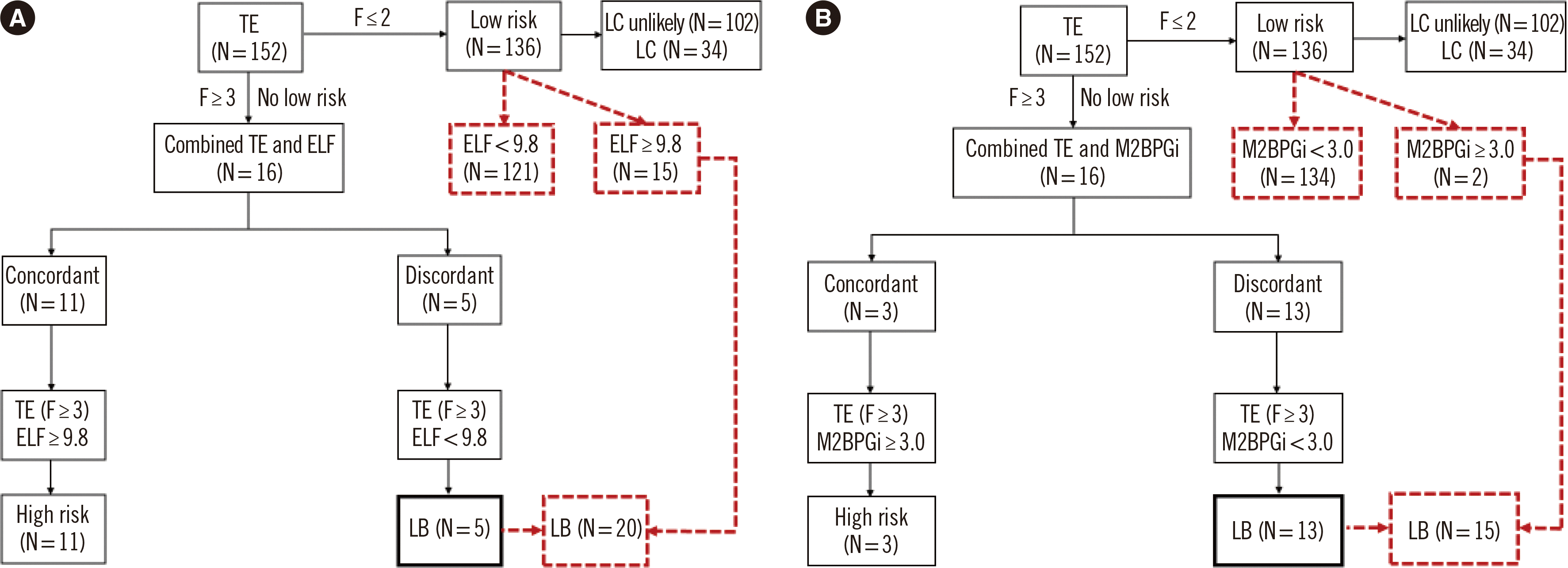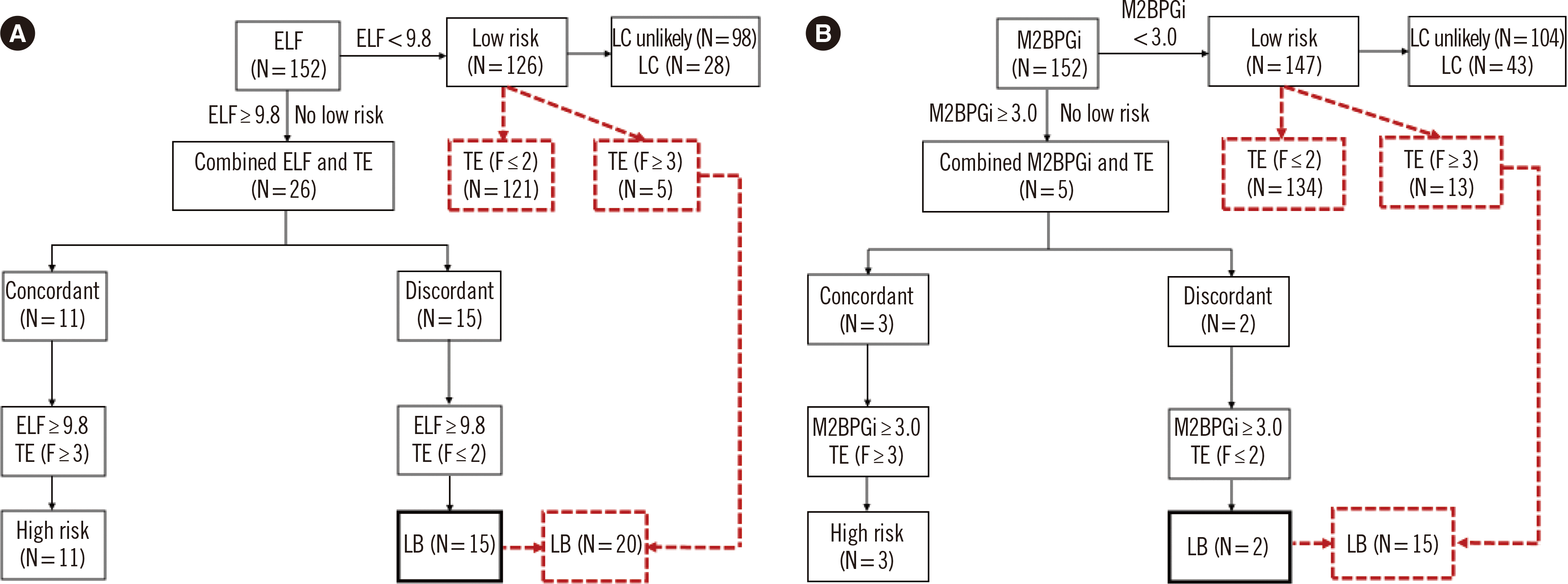1. Rockey DC, Bell PD, Hill JA. 2015; Fibrosis-a common pathway to organ injury and failure. N Engl J Med. 372:1138–49. DOI:
10.1056/NEJMra1300575. PMID:
25785971.
3. Pellicoro A, Ramachandran P, Iredale JP, Fallowfield JA. 2014; Liver fibrosis and repair: immune regulation of wound healing in a solid organ. Nat Rev Immunol. 14:181–94. DOI:
10.1038/nri3623. PMID:
24566915.

4. Soresi M, Giannitrapani L, Cervello M, Licata A, Montalto G. 2014; Non invasive tools for the diagnosis of liver cirrhosis. World J Gastroenterol. 20:18131–50. DOI:
10.3748/wjg.v20.i48.18131. PMID:
25561782. PMCID:
PMC4277952.

6. Rousselet MC, Michalak S, Dupré F, Croué A, Bedossa P, Saint-André JP, et al. 2005; Sources of variability in histological scoring of chronic viral hepatitis. Hepatology. 41:257–64. DOI:
10.1002/hep.20535. PMID:
15660389.

7. Liu T, Wang X, Karsdal MA, Leeming DJ, Genovese F. 2012; Molecular serum markers of liver fibrosis. Biomark Insights. 7:105–17. DOI:
10.4137/BMI.S10009. PMID:
22872786. PMCID:
PMC3412619.

8. Kim SU, Kim BK, Han KH. 2013; Clinical application of liver stiffness measurement using transient elastography: a surgical perspective. Digestion. 88:258–65. DOI:
10.1159/000355948. PMID:
24335341.

9. Tsochatzis EA, Gurusamy KS, Ntaoula S, Cholongitas E, Davidson BR, Burroughs AK. 2011; Elastography for the diagnosis of severity of fibrosis in chronic liver disease: a meta-analysis of diagnostic accuracy. J Hepatol. 54:650–9. DOI:
10.1016/j.jhep.2010.07.033. PMID:
21146892.

10. Kim MN, Kim SU, Kim BK, Park JY, Kim DY, Ahn SH, et al. 2015; Increased risk of hepatocellular carcinoma in chronic hepatitis B patients with transient elastography-defined subclinical cirrhosis. Hepatology. 61:1851–9. DOI:
10.1002/hep.27735. PMID:
25643638.

11. Friedrich-Rust M, Poynard T, Castera L. 2016; Critical comparison of elastography methods to assess chronic liver disease. Nat Rev Gastroenterol Hepatol. 13:402–11. DOI:
10.1038/nrgastro.2016.86. PMID:
27273167.

12. Lichtinghagen R, Pietsch D, Bantel H, Manns MP, Brand K, Bahr MJ. 2013; The Enhanced Liver Fibrosis (ELF) score: normal values, influence factors and proposed cut-off values. J Hepatol. 59:236–42. DOI:
10.1016/j.jhep.2013.03.016. PMID:
23523583.

13. Narimatsu H. 2015; Development of M2BPGi: a novel fibrosis serum glyco-biomarker for chronic hepatitis/cirrhosis diagnostics. Expert Rev Proteomics. 12:683–93. DOI:
10.1586/14789450.2015.1084874. PMID:
26394846.

14. Shirabe K, Bekki Y, Gantumur D, Araki K, Ishii N, Kuno A, et al. 2018; Mac-2 binding protein glycan isomer (M2BPGi) is a new serum biomarker for assessing liver fibrosis: more than a biomarker of liver fibrosis. J Gastroenterol. 53:819–26. DOI:
10.1007/s00535-017-1425-z. PMID:
29318378.

16. Tamaki N, Kurosaki M, Loomba R, Izumi N. 2021; Clinical utility of Mac-2 binding protein glycosylation isomer in chronic liver diseases. Ann Lab Med. 41:16–24. DOI:
10.3343/alm.2021.41.1.16. PMID:
32829576. PMCID:
PMC7443525.

17. Jang SY, Tak WY, Park SY, Kweon YO, Lee YR, Kim G, et al. 2021; Diagnostic efficacy of serum Mac-2 binding protein glycosylation isomer and other markers for liver fibrosis in non-alcoholic fatty liver diseases. Ann Lab Med. 41:302–9. DOI:
10.3343/alm.2021.41.3.302. PMID:
33303715. PMCID:
PMC7748098.

18. Moon HW, Park M, Hur M, Kim H, Choe WH, Yun YM. 2018; Usefulness of enhanced liver fibrosis, glycosylation isomer of Mac-2 binding protein, galectin-3, and soluble suppression of tumorigenicity 2 for assessing liver fibrosis in chronic liver diseases. Ann Lab Med. 38:331–7. DOI:
10.3343/alm.2018.38.4.331. PMID:
29611383. PMCID:
PMC5895862.

19. Jekarl DW, Choi H, Lee S, Kwon JH, Lee SW, Yu H, et al. 2018; Diagnosis of liver fibrosis with Wisteria floribunda agglutinin-positive Mac-2 binding protein (WFA-M2BP) among chronic hepatitis B patients. Ann Lab Med. 38:348–54. DOI:
10.3343/alm.2018.38.4.348. PMID:
29611385. PMCID:
PMC5895864.

20. Castéra L, Sebastiani G, Le Bail B, de Lédinghen V, Couzigou P, Alberti A. 2010; Prospective comparison of two algorithms combining non-invasive methods for staging liver fibrosis in chronic hepatitis C. J Hepatol. 52:191–8. DOI:
10.1016/j.jhep.2009.11.008. PMID:
20006397.

21. Wong GL, Chan HL, Choi PC, Chan AW, Yu Z, Lai JW, et al. 2014; Non-invasive algorithm of enhanced liver fibrosis and liver stiffness measurement with transient elastography for advanced liver fibrosis in chronic hepatitis B. Aliment Pharmacol Ther. 39:197–208. DOI:
10.1111/apt.12559. PMID:
24261924.

22. Petta S, Vanni E, Bugianesi E, Di Marco V, Cammà C, Cabibi D, et al. 2015; The combination of liver stiffness measurement and NAFLD fibrosis score improves the noninvasive diagnostic accuracy for severe liver fibrosis in patients with nonalcoholic fatty liver disease. Liver Int. 35:1566–73. DOI:
10.1111/liv.12584. PMID:
24798049.

23. Calès P, Boursier J, Lebigot J, de Ledinghen V, Aubé C, Hubert I, et al. 2017; Liver fibrosis diagnosis by blood test and elastography in chronic hepatitis C: agreement or combination? Aliment Pharmacol Ther. 45:991–1003. DOI:
10.1111/apt.13954. PMID:
28164327.

24. European Association for Study of Liver; Asociacion Latinoamericana para el Estudio del Higado. 2015; EASL-ALEH Clinical Practice Guidelines: non-invasive tests for evaluation of liver disease severity and prognosis. J Hepatol. 63:237–64. DOI:
10.1016/j.jhep.2015.04.006. PMID:
25911335.
25. Tapper EB, Lok ASF. 2017; Use of liver imaging and biopsy in clinical practice. N Engl J Med. 377:2296–7. DOI:
10.1056/NEJMra1610570. PMID:
28834467.

26. Yoneda M, Imajo K, Takahashi H, Ogawa Y, Eguchi Y, Sumida Y, et al. 2018; Clinical strategy of diagnosing and following patients with nonalcoholic fatty liver disease based on invasive and noninvasive methods. J Gastroenterol. 53:181–96. DOI:
10.1007/s00535-017-1414-2. PMID:
29177681. PMCID:
PMC5846871.

28. Sterling RK, Lissen E, Clumeck N, Sola R, Correa MC, Montaner J, et al. 2006; Development of a simple noninvasive index to predict significant fibrosis in patients with HIV/HCV coinfection. Hepatology. 43:1317–25. DOI:
10.1002/hep.21178. PMID:
16729309.

29. Kuno A, Ikehara Y, Tanaka Y, Ito K, Matsuda A, Sekiya S, et al. 2013; A serum "sweet-doughnut" protein facilitates fibrosis evaluation and therapy assessment in patients with viral hepatitis. Sci Rep. 3:1065. DOI:
10.1038/srep01065. PMID:
23323209. PMCID:
PMC3545220.

30. Sim J, Wright CC. 2005; The kappa statistic in reliability studies: use, interpretation, and sample size requirements. Phys Ther. 85:257–68. DOI:
10.1093/ptj/85.3.257. PMID:
15733050.

31. Inadomi C, Takahashi H, Ogawa Y, Oeda S, Imajo K, Kubotsu Y, et al. 2020; Accuracy of the enhanced liver fibrosis test, and combination of the enhanced liver fibrosis and non-invasive tests for the diagnosis of advanced liver fibrosis in patients with non-alcoholic fatty liver disease. Hepatol Res. 50:682–92. DOI:
10.1111/hepr.13495. PMID:
32090397.

32. Boursier J, de Ledinghen V, Leroy V, Anty R, Francque S, Salmon D, et al. 2017; A stepwise algorithm using an at-a-glance first-line test for the non-invasive diagnosis of advanced liver fibrosis and cirrhosis. J Hepatol. 66:1158–65. DOI:
10.1016/j.jhep.2017.01.003. PMID:
28088581.

34. Marcellin P, Gane E, Buti M, Afdhal N, Sievert W, Jacobson IM, et al. 2013; Regression of cirrhosis during treatment with tenofovir disoproxil fumarate for chronic hepatitis B: a 5 year open-label follow up study. Lancet. 381:468–75. DOI:
10.1016/S0140-6736(12)61425-1. PMID:
23234725.
35. Faul F, Erdfelder E, Lang AG, Buchner A. 2007; G*Power 3: a flexible statistical power analysis program for the social, behavioral, and biomedical sciences. Behav Res Methods. 39:175–91. DOI:
10.3758/BF03193146. PMID:
17695343.

36. Kim HY. 2016; Statistical notes for clinical researchers: sample size calculation 2. Comparison of two independent proportions. Restor Dent Endod. 41:154–6. DOI:
10.5395/rde.2016.41.2.154. PMID:
27200285. PMCID:
PMC4868880.







 PDF
PDF Citation
Citation Print
Print



 XML Download
XML Download